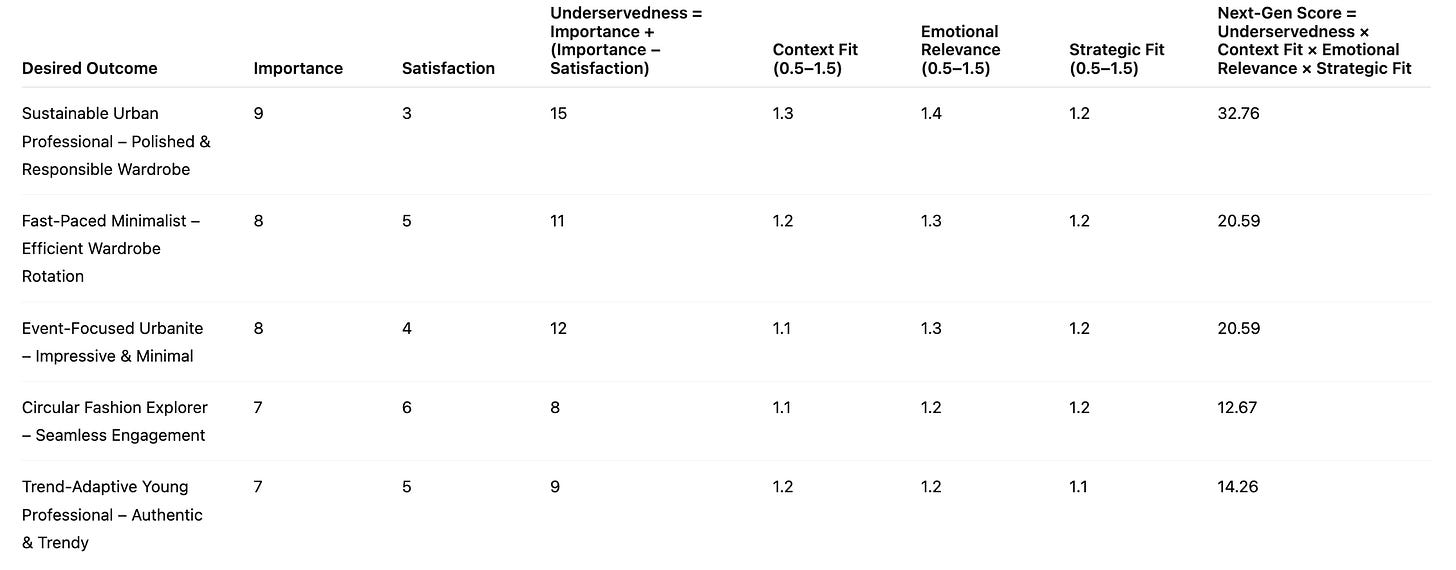The Hidden Jobs of Fashion: A JTBD Perspective

In European cities, fashion is not merely about clothing; it’s a complex interplay of identity, emotion, social belonging, and sustainability. This dynamic is evident when contrasting two global narratives: In Zürich, the city is piloting programs to reuse old clothes locally, aiming to reduce waste while keeping garments within the community SRF.CH. Meanwhile, in Accra, Ghana, large volumes of secondhand clothes arrive daily, but nearly 40% are unwearable, creating environmental hazards and community friction FAZ.NET.
These contrasting scenarios highlight a significant issue: current fashion delivery and recycling systems fail to deliver the outcomes urban Europeans truly seek. People aren’t just purchasing garments; they’re hiring them to express identity, navigate social pressures, act sustainably, manage time, and preserve personal meaning.
By applying a Jobs-to-be-Done (JTBD) lens, we can systematically explore urban job performers, their desired outcomes, friction points, and opportunity spaces, then prioritize opportunities and inspire innovation that resonates at both individual and societal levels.
Job Performers and Their Desired Outcomes
Job Performer 1 – The Sustainable Urban Professional
Who: Office workers or knowledge workers in cities like Berlin, Zurich, Amsterdam.
Pain Points: Struggling to balance professional style with environmental responsibility; guilt over overconsumption.
Desired Outcome: Maintain a polished, authentic wardrobe with minimal environmental footprint.
Metricized Outcome Examples:
Reduce wardrobe guilt from 8/10 → 3/10
Reduce unnecessary purchases from 2/week → 0.5/week
JTBD Problem Prompt:
When dressing for work or social occasions, I want to maintain a polished and authentic wardrobe while minimizing environmental impact, so I can feel confident, responsible, and aligned with my values.
Job Performer 2 – The Fast-Paced Minimalist
Who: Young urbanites juggling work, social life, commuting, and travel.
Pain Points: Closet is small, time is limited, fashion decisions are overwhelming.
Desired Outcome: Rotate outfits efficiently, feel stylish and confident, reduce decision fatigue.
Metricized Outcome Examples:
Reduce wardrobe decision time from 15 min/day → 5 min/day
Reduce stress about outfit rotate choice from 7/10 → 2/10
JTBD Problem Prompt:
When selecting what to wear, I want to rotate outfits efficiently without stress, so I can feel stylish, confident, and free to focus on my day.
Job Performer 3 – The Event-Focused Urbanite
Who: City dwellers attending work events, parties, cultural events.
Pain Points: Needs high-impact looks for special occasions without buying items that sit unused afterward.
Desired Outcome: Express identity and impress socially while avoiding accumulation and waste.
Metricized Outcome Examples:
Reduce time and cost for sourcing event outfits by 50%
Increase satisfaction with event appearance from 6/10 → 9/10
JTBD Problem Prompt:
When preparing for special events, I want to look impressive and authentic without accumulating unnecessary garments, so I can feel confident, stylish, and responsible.
Job Performer 4 – The Circular Fashion Explorer
Who: Conscious consumer who actively seeks secondhand, rental, or upcycled clothing.
Pain Points: Shops and platforms are fragmented, inconvenient, or socially awkward; struggle to make circular fashion practical.
Desired Outcome: Participate in circular fashion effortlessly, maintain social acceptance and self-expression.
Metricized Outcome Examples:
Increase ease of engaging with circular fashion from 4/10 → 9/10
Increase proportion of wardrobe sustainably sourced from 15% → 50%
JTBD Problem Prompt:
When engaging in secondhand or rental fashion, I want the experience to be seamless and socially comfortable, so I can enjoy style, sustainability, and belonging.
Job Performer 5 – The Trend-Adaptive Young Professional
Who: Wants to balance personal style with fast-moving trends, often using Instagram, TikTok for inspiration.
Pain Points: Pressure to appear stylish in professional and social contexts, without overconsumption or fast-fashion guilt.
Desired Outcome: Stay on-trend authentically while controlling spending, wardrobe size, and environmental impact.
Metricized Outcome Examples:
Reduce fast-fashion spending from €200/month → €50/month
Increase confidence in style choices from 5/10 → 9/10
JTBD Problem Prompt:
When following trends, I want to stay stylish and authentic without over-consuming or feeling guilty, so I can express myself, impress socially, and respect my values.
Mapping the Job Journey: Fast-Paced Minimalist Example
Steps:
Identify Need: “I need an outfit for today.”
Explore Options: Open closet, browse apps, check trends.
Select Outfit: Make decision based on style, context, sustainability.
Experience Outcome: Judge appearance, comfort, social feedback.
Dispose / Rotate: Donate, swap, or store unused garments.
Friction Points & Forces of Progress:
Push: Clutter, decision fatigue, fast-fashion temptation
Pull: Desire for efficiency, style, and alignment with values
Anxieties: Social judgment, waste, overbuying
Habit: Convenience-driven fast fashion, passive donation patterns
Insight: Mapping the full journey uncovers hidden opportunity spaces at functional, emotional, social, and aspirational levels.
Prioritizing Outcomes with Next-Gen Scoring
Unvalidated fictive example
Key Insight: The Sustainable Urban Professional outcome is the most strategically and emotionally impactful, combining daily frequency, underservedness, and alignment with personal and systemic impact.
Deep Dive: Sustainable Urban Professional
Functional Needs: Polished wardrobe, efficient rotations, minimal waste.
Emotional Needs: Pride, confidence, guilt-free satisfaction.
Social Needs: Acceptance, recognition, alignment with peers.
Aspirational Needs: Express values, environmental contribution, personal style evolution.
Refined JTBD Problem Prompt:
When dressing for work or social occasions, I want to maintain a polished and authentic wardrobe while minimizing environmental impact, so I can feel confident, responsible, and aligned with my values.
10 High-Level Solution Idea Candidates (Urban Europe Focus)
Each idea addresses one or more underserved outcome dimensions, while remaining broad enough for creative exploration.
Macro & Systems Perspective
Zürich: Local reuse is promising but often fails to fully address emotional and social dimensions.
Ghana: Overwhelming waste results from fragmented systems and unmet desired outcomes.
Insight: Innovations that target actual job outcomes can create cascading benefits: environmental, social, and emotional. Even small improvements in the urban European context could reduce waste, increase satisfaction, and strengthen community networks.
Lessons Learned
Start with desired outcomes, not solutions.
Map full job journeys and friction points.
Identify forces of progress (push, pull, anxieties, habits).
Prioritize using Next-Gen scoring to target high-impact, underserved outcomes.
Use diverse idea candidates to inspire creative solutions.
Connect micro-level human outcomes to macro-level systemic impact.
If you want to uncover the hidden jobs your customers are hiring your products to do, map, score, and prioritize them using Next-Gen opportunity scoring, and turn insights into solutions that are emotionally resonant, socially meaningful, and strategically impactful, I help teams design these opportunities.
Together, we can create solutions that redefine markets and elevate human experience.
References / Contextual Reading:





